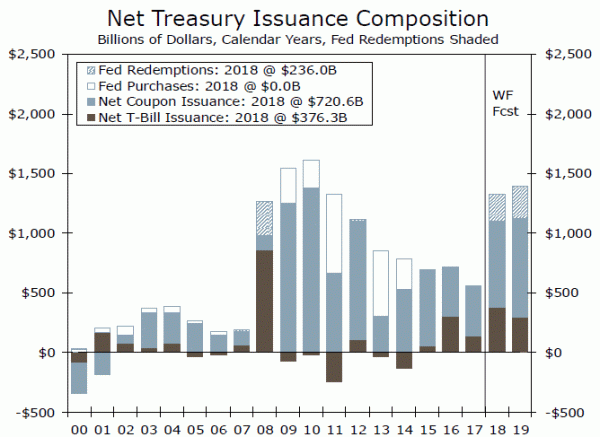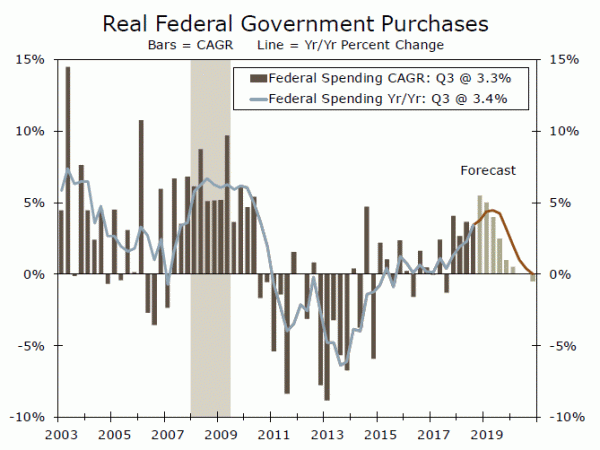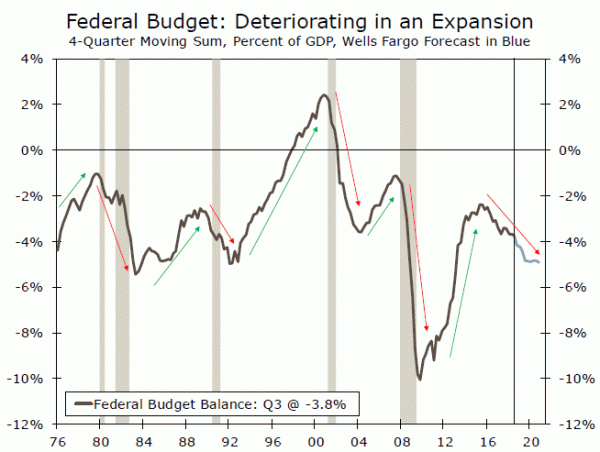In a previous report, we outlined our thinking on policy and the economic outlook headed into the midterm elections. In this report, we provide a brief update based off of last night’s election results.
Another Fiscal Inflection Point? Probably not.
On October 22, we put out a report titled “The Midterm Elections and Our Economic Outlook” that took a deep dive into how we were thinking about potential policy outcomes heading into the midterm elections. Broadly speaking, the results from last night do not materially change our views.
The 2016 election was a watershed election, resulting in the first Republican unified government since 2005-2006 and producing a clear inflection point in the nation’s fiscal policy (top chart). Divided government, under which the U.S. will operate come 2019, has been more common and generally less conducive to sweeping legislative changes. More specifically as it relates to our outlook, it seems unlikely that Republicans in the Senate and White House will agree to any major changes to the 2017 tax reform bill proposed by Democrats in the House. Conversely, Democrats in the House are unlikely to agree to tax cuts anywhere near the magnitude that occurred in 2017.
The spending side of the ledger has a murkier outlook. At present, the United States is operating under a two-year budget deal that expires on September 30, 2019. Under current law, inflation-adjusted discretionary spending would outright decline in FY 2020, leading the federal component of GDP to be a drag on economic growth, as it was from roughly 2011-2014. This period, which saw a significant contraction in discretionary spending, eventually gave way to divided government legislation that led federal government consumption and investment to have a much more neutral impact on economic growth. Our forecast assumes something similar; a bipartisan effort succeeds in staving off another fiscal contraction, but the significant boost that occurred in 2018 is not repeated (middle chart).
While this is our base case, we believe a plausible case could be made for swings in either direction. President Trump has appeared sympathetic to policy stimulus of all kinds, and a slowdown in growth headed into the 2020 election might lead policymakers to boost spending more meaningfully than we currently have forecasted. Alternatively, it is easy to imagine a scenario where a divided Congress and the president engage in a prolonged budget standoff next year that results in a debt ceiling debacle and a sharper deceleration in federal government spending than we currently envision.
Given this baseline, what do the elections mean for our interest rate outlook? Unlike 2016, we do not currently believe the 2018 midterms will spark policy outcomes that provide a significant boost to growth and a subsequently more hawkish Fed. For Treasury supply, our base case is for the deficit to continue widening over the next few quarters, but for the pace of widening to slow by H2-2019. More specifically, we look for a budget deficit of $1.05 trillion in FY 2019 and $1.1 trillion in FY 2020. As a result, though the level of net Treasury issuance will remain high, the pace of growth is also likely to slow, (bottom chart).















